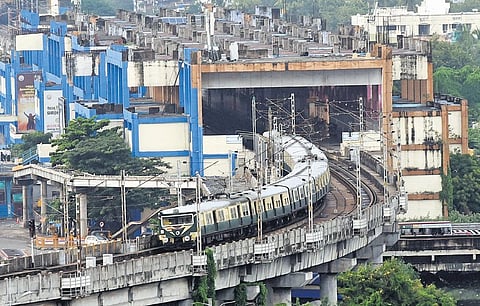

CHENNAI: The Chennai Unified Metropolitan Transport Authority (CUMTA) is seeking government approval for a draft memorandum of understanding (MoU) to take over the Mass Rapid Transit System (MRTS) after Southern Railway agreed to hand over the transit system completely to the state government on an ‘as is where is’ basis.
Sources said Southern Railway also has offered to extend ‘hand-holding’ support in operations and maintenance for one year free of cost during the transition period from the date of execution of the MoU, as Chennai Metro rail which is likely to take over the operations of MRTS doesn’t have the expertise to run trains. They said EMU coaches procured with the state government fund will be given for the operation to the state and if they are handed over back to Indian Railways, it will be paid back or adjusted with the state at depreciated value.
This could mean the state is likely to rebuild the MRTS infrastructure on a par with Chennai Metro after acquiring it. Sources said the existing EMU fleet in the MRTS system of Southern Railway will be given to the state free of cost for two years and on payment of lease charges beyond two years from the date of execution of the MoU.
After two years, the lease charges may be finalised by the committee of Southern Railway and the state government. In the meantime, a special purpose vehicle will be procuring a new fleet of EMU coaches, official sources said. Similarly, connectivity will be provided from the MRTS system to the Southern Railway system through a crossover operated by Chennai Beach station of Southern Railway for any emergency movement of coaches or trains to and from Southern Railway.
The railway shall support the restoration of train derailments, if any, in the MRTS system with the due request by the special purpose vehicle. The prescribed charges will be paid by the proposed special-purpose vehicle. MRTS ticketing counter in Chennai Fort Station and Chennai Beach Station along with MRTS ticketing counter in the terminal building, MRTS Automatic Ticket Vending Machines (ATVM), direction signages to the MRTS platform, passenger Information System and route maps in the prominent locations (Static and Dynamic) and permission to make announcement on the arrival and departure of MRTS trains in the terminal building and platforms shall be permitted free of cost by Southern Railways.
Currently, the MRTS corridor is facing challenges of decreasing patronage. Designed to carry a capacity of more than 6 lakh passengers per day, the current patronage is approximately 14% of what it was designed. A major issue has been poor passenger facilities and amenities. The major complaint from passengers is the security threat posed by isolated space in the huge MRTS buildings which were supposed to be commercially exploited and have not been done.
It was proposed that the state completely take over the MRTS assets and operations and maintenance from Southern Railway to ensure effective multi-modal integration to augment the passenger ridership and commercial utilisation of MRTS stations. This will eventually improve Urban Mobility and contribute to the reduction in traffic congestion. Land parcels which are owned by Southern Railway and used for the MRTS operations will be handed over to the state. The plan needs to be finalised by Southern Railway in consultation with the state government, sources said.
What’s ‘as is where is’
‘As is where is’ is a clause in an agreement which implies that the thing so contracted is transferred, by one person to another in its existing condition and the transferee has accepted it with all its faults and defects, whether or not immediately apparent
Factfile